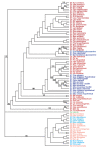Examining ancient inter-domain horizontal gene transfer
- PMID: 19204812
- PMCID: PMC2614185
Examining ancient inter-domain horizontal gene transfer
Abstract
Details of the genomic changes that occurred in the ancestors of Eukarya, Archaea and Bacteria are elusive. Ancient interdomain horizontal gene transfer (IDHGT) amongst the ancestors of these three domains has been difficult to detect and analyze because of the extreme degree of divergence of genes in these three domains and because most evidence for such events are poorly supported. In addition, many researchers have suggested that the prevalence of IDHGT events early in the evolution of life would most likely obscure the patterns of divergence of major groups of organisms let alone allow the tracking of horizontal transfer at this level. In order to approach this problem, we mined the E. coli genome for genes with distinct paralogs. Using the 1,268 E. coli K-12 genes with 40% or higher similarity level to a paralog elsewhere in the E. coli genome we detected 95 genes found exclusively in Bacteria and Archaea and 86 genes found in Bacteria and Eukarya. These genes form the basis for our analysis of IDHGT. We also applied a newly developed statistical test (the node height test), to examine the robustness of these inferences and to corroborate the phylogenetically identified cases of ancient IDHGT. Our results suggest that ancient inter domain HGT is restricted to special cases, mostly involving symbiosis in eukaryotes and specific adaptations in prokaryotes. Only three genes in the Bacteria + Eukarya class (Deoxyxylulose-5-phosphate synthase (DXPS), fructose 1,6-phosphate aldolase class II protein and glucosamine-6-phosphate deaminase) and three genes-in the Bacteria + Archaea class (ABC-type FE3+-siderophore transport system, ferrous iron transport protein B, and dipeptide transport protein) showed evidence of ancient IDHGT. However, we conclude that robust estimates of IDHGT will be very difficult to obtain due to the methodological limitations and the extreme sequence saturation of the genes suspected of being involved in IDHGT.
Keywords: blast; eschericia coli; horizontal gene transfer; node height test.
Figures



Similar articles
-
Recent events dominate interdomain lateral gene transfers between prokaryotes and eukaryotes and, with the exception of endosymbiotic gene transfers, few ancient transfer events persist.Philos Trans R Soc Lond B Biol Sci. 2015 Sep 26;370(1678):20140324. doi: 10.1098/rstb.2014.0324. Philos Trans R Soc Lond B Biol Sci. 2015. PMID: 26323756 Free PMC article.
-
Horizontal Gene Transfers in prokaryotes show differential preferences for metabolic and translational genes.BMC Evol Biol. 2009 Jan 10;9:9. doi: 10.1186/1471-2148-9-9. BMC Evol Biol. 2009. PMID: 19134215 Free PMC article.
-
The p-type ATPase superfamily.J Mol Microbiol Biotechnol. 2010;19(1-2):5-104. doi: 10.1159/000319588. Epub 2010 Oct 20. J Mol Microbiol Biotechnol. 2010. PMID: 20962537 Review.
-
Horizontal Gene Transfer Building Prokaryote Genomes: Genes Related to Exchange Between Cell and Environment are Frequently Transferred.J Mol Evol. 2018 Apr;86(3-4):190-203. doi: 10.1007/s00239-018-9836-x. Epub 2018 Mar 19. J Mol Evol. 2018. PMID: 29556740
-
STAND, a class of P-loop NTPases including animal and plant regulators of programmed cell death: multiple, complex domain architectures, unusual phyletic patterns, and evolution by horizontal gene transfer.J Mol Biol. 2004 Oct 8;343(1):1-28. doi: 10.1016/j.jmb.2004.08.023. J Mol Biol. 2004. PMID: 15381417 Review.
Cited by
-
Horizontal gene transfer in evolution: facts and challenges.Proc Biol Sci. 2010 Mar 22;277(1683):819-27. doi: 10.1098/rspb.2009.1679. Epub 2009 Oct 28. Proc Biol Sci. 2010. PMID: 19864285 Free PMC article. Review.
-
Horizontal gene transfer: sustaining pathogenicity and optimizing host-pathogen interactions.Mol Plant Pathol. 2009 Jan;10(1):143-50. doi: 10.1111/j.1364-3703.2008.00518.x. Mol Plant Pathol. 2009. PMID: 19161360 Free PMC article. Review.
-
Recent events dominate interdomain lateral gene transfers between prokaryotes and eukaryotes and, with the exception of endosymbiotic gene transfers, few ancient transfer events persist.Philos Trans R Soc Lond B Biol Sci. 2015 Sep 26;370(1678):20140324. doi: 10.1098/rstb.2014.0324. Philos Trans R Soc Lond B Biol Sci. 2015. PMID: 26323756 Free PMC article.
-
Phylogenomic analysis demonstrates a pattern of rare and ancient horizontal gene transfer between plants and fungi.Plant Cell. 2009 Jul;21(7):1897-911. doi: 10.1105/tpc.109.065805. Epub 2009 Jul 7. Plant Cell. 2009. PMID: 19584142 Free PMC article.
-
Human polynucleotide phosphorylase (hPNPase(old-35)): an evolutionary conserved gene with an expanding repertoire of RNA degradation functions.Oncogene. 2011 Apr 14;30(15):1733-43. doi: 10.1038/onc.2010.572. Epub 2010 Dec 13. Oncogene. 2011. PMID: 21151174 Free PMC article. Review.
References
-
- Andersson JO, Sjogren AM, Davis LA, Embley TM, Roger AJ. Phylogenetic analyses of diplomonad genes reveal frequent lateral gene transfers affecting eukaryotes. Curr Biol. 2003;13(2):94–104. - PubMed
-
- Andersson JO, Sarchfield SW, Roger AJ, Sjogren AM, Davis LA, Embley TM. Gene Transfers from Nanoarchaeota to an Ancestor of Diplomonads and Parabasalids—Phylogenetic analyses of diplomonad genes reveal frequent lateral gene transfers affecting eukaryotes. Mol Biol Evol. 2005;22(1):85–90. - PubMed
-
- Aravind L, Tatusov RL, Wolf YI, Walker DR, Koonin EV. Evidence for massive gene exchange between archaeal and bacterial hyperthermophiles. Trends Genet. 1998;14(11):442–4. - PubMed
-
- Berg OG, Kurland CG. Why mitochondrial genes are most often found in nuclei. Mol Biol Evol. 2000;17(6):951–61. - PubMed
-
- Benachenhou-Lahfa N, Forterre P, Labedan B. Evolution of glutamate dehydrogenase genes: Evidence for paralogous protein families and unusual branching patterns of the archaebacteria in the universal tree of life. J Mol Evol. 1993;36:335–46. - PubMed
LinkOut - more resources
Full Text Sources
Research Materials
